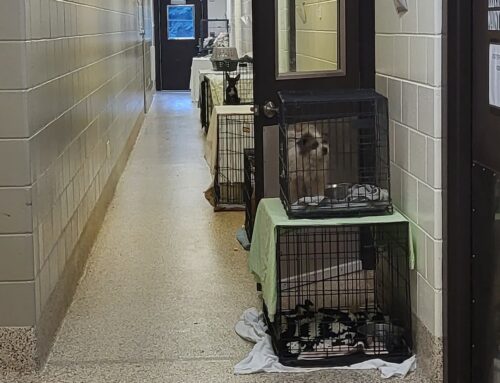By Sarah Neikam, Director of Operations
Last week, an adopted dog was returned to the SPCA Albrecht Center after only a few weeks in his new home. It happens. Sometimes a dog doesn’t get along with the other pets, or he’s not house training quickly enough, or he’s chewed a favorite pair of shoes, or any number of other challenges that the adopter is either not able to or just not willing to take the time to resolve.
This dog was returned for a different reason though. The adopter came to the mistaken realization that the dog’s implanted microchip was a tracking device and maybe even a sinister branding, and that unless we removed it, he would not be keeping the dog.
Neither of these claims are true, of course. So, to help clear up these and other misconceptions, here are a few common pet microchip myths, and the facts to clarify them.
Myth: Pet microchips act as GPS tracking devices.
Fact: Pet microchips are tiny, about the size of a grain of rice, too small to contain any sort of power source, like a battery, which they would need in order to emit a GPS signal. The chip is completely passive until a microchip scanner is passed over it. The scanner is programmed to read the unique code contained inside the microchip, in the same way that a grocery store scanner reads a bar code. This code is provided to the microchip registration company and they are able to provide the pet owner’s contact information that is linked to that code. No other personal information is stored within the microchip or registry, and the chip does not emit any sort of trackable signal.
Myth: Microchip implantation is painful.
Fact: As mentioned above, microchips are tiny, so they are inserted with a small needle in a quick, virtually painless procedure. It’s no more painful than getting a vaccination, and usually only needs to be done once in a pet’s lifetime, unlike vaccinations.
Myth: Indoor pets don’t need a microchip.
Fact: Even indoor pets have to go outside sometime; to use the bathroom, visit the vet, groomer, or travel with their family. And cats can slip out of doors or carriers, dogs can slip out of leashes, jump out of car windows or dig under fences. A microchip can provide peace of mind in case your pet becomes separated from you or their home by giving them a higher chance of return to you.
Myth: Microchipping my pet doesn’t really increase its chances of being found if lost.
Fact: The American Veterinary Medical Association conducted a study of more than 7,700 stray animals at animal shelters and revealed a 21.9% return-to-owner rate for dogs with no microchip, versus a 52.2% return-to-owner rate for dogs who were microchipped. Cats without microchips had only a 1.8% return-to-owner rate, versus 38.5% for microchipped cats.
The microchip alone is not enough though. Some microchipped animals aren’t returned to their owners due to incorrect or no owner information in the microchip registry database, so make sure to register your pet’s microchip and keep it updated when you move or change phone numbers. Not sure how? Contact the microchip company if you know it, or your veterinarian or the shelter where you adopted your pet.
If you have a pet that is not microchipped, please consider the facts and make it a priority. The SPCA Albrecht Center’s Veterinary Care Center offers the service for just $25, and you don’t even have to make an appointment. Call 803-648-6864 or visit SPCAVetCare.org for hours.
And if you’re considering adopting a pet, you’ll be glad to know that pets adopted from the SPCA Albrecht Center are conveniently already microchipped, and shelter staff will help update the microchip registry information so that your new pet has a much higher chance of return to you in case they ever stray from home.




